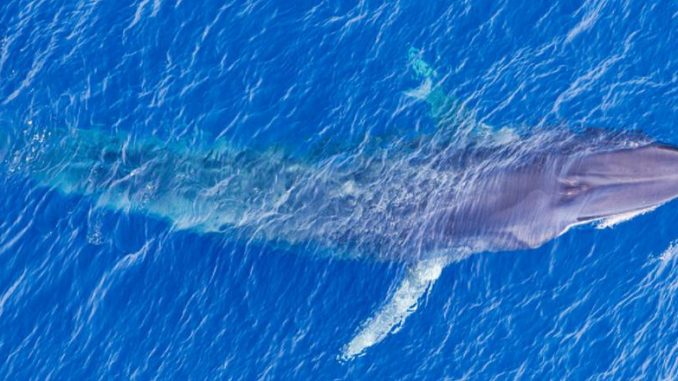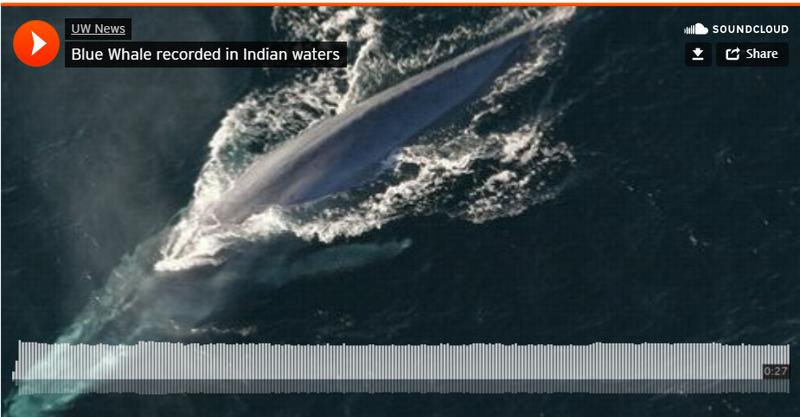
KOCHI, Kerala, India, July 5, 2021 (ENS) – Endangered blue whales are present and singing off the southwest coast of India, scientists from the University of Washington demonstrate in a new research study of an area once plundered by illegal Soviet whalers. They advise that today’s conservation measures should include this region, which is considering expanding tourism.
“The presence of blue whales in Indian waters is well known from several strandings and some live sightings of blue whales,” said lead author Divya Panicker, a UW doctoral student in oceanography. “But basic questions such as where blue whales are found, what songs do they sing, what do they eat, how long do they spend in Indian waters and in what seasons are still largely a mystery.”

Answers to those questions will be important for the region, which is also experiencing effects of climate change, she said.
Analysis of recordings from late 2018 to early 2020 made in Lakshadweep, an archipelago of 36 low-lying islands west of the Indian state of Kerala, detected blue whales with a peak activity in April and May.
“This study provides conclusive evidence for the persistent occurrence of blue whales in Lakshadweep,” Panicker said. “It is critical to answer these questions to draw up science-based management and conservation plans here.”
The study https://onlinelibrary.wiley.com/doi/10.1111/mms.12827 was published in May in the journal “Marine Mammal Science.”
While gigantic blue whales, Balenoptera musculus spp., the world’s largest whale species, feed in the waters around Antarctica, four populations of smaller pygmy blue whales are known to inhabit the Indian Ocean. These smaller blue whales belong to two subspecies, B.m. brevicauda and B.m. indica, categorized by their distinct song types.
In previous research, Panicker, who grew up in the coastal city of Cochin, now called Kochi, in India’s Kerala state, talked to local fishers who reported seeing whales blowing during the spring months.
But since whales surface only occasionally and sound waves travel well in water, the best way to study whales is the same way they communicate – underwater, Panicker decided.

The typical blue whale song is a series of one to six low moans, each up to 20 seconds long, below the threshold of human hearing. The pattern and number of moans varies for different populations.
Songs provide insights into this poorly studied population; a possible new song was recently reported in the central Indian Ocean and off the coasts of Madagascar and Oman.
For Panicker’s study, scuba divers placed underwater microphones at two ends of Kavaratti Island. Other studies in nearby waters suggested that the presence of blue whales would be seasonal, and recordings confirmed their presence between the winter and summer monsoons.
“Our study extends the known range of this song type a further 1,000 kilometers (620 miles) northwest of Sri Lanka,” Panicker said. “Our study provides the first evidence for northern Indian Ocean blue whale songs in Indian waters.”
The researchers believe that the whales are likely resident in the northern Indian Ocean, and come to the Lakshadweep atoll seasonally.
“The Indian Ocean is clearly important habitat for blue whales – an endangered species that is only very slowly recovering from 20th-century commercial and illegal whaling, especially in the Indian Ocean,” said senior author Kate Stafford, an oceanographer at the University of Washington’s Applied Physics Laboratory.
Future work by another UW research group will use recordings of blue whales in the Indian Ocean to calculate their historic numbers and better understand how historic whaling affected different populations in this region.
This research was funded by the U.S. Navy’s Office of Naval Research through its Marine Mammal and Biology Program.
Featured image: A pygmy blue whale (Balaenoptera musculus brevicauda) breaks the surface in waters 250 miles west of Maputo, Mozambique. (Photo © Paul Hilton / Greenpeace republished under Creative Commons license)
© 2021, Environment News Service. All rights reserved. Content may be quoted only with proper attribution and a direct link to the original article. Full reproduction is prohibited.



